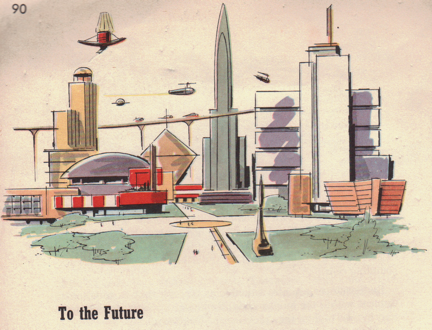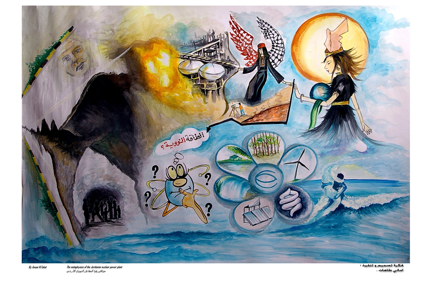To the Future

The image above is from the "Atomic Energy" edition of the "Standard Treasury of Learning Dictionary for Young People," circa 1960. Some of the chapters related to nuclear energy are titled "Unlimited Power" and "Food Enough for Everyone." It is good to be reminded that the nuclear energy industry has always had noble ambitions. This book has served as an inspiration recently, as I find myself wondering, "What will the future look like?"
Much of our energy future depends on how the industry handles outreach and education in a post-Fukushima world. The more that people know about nuclear energy, the less scary it is. In the modern world, however, useful information is in constant battle with sensationalized reporting and false conclusions. The scariest part about this situation for me is that our energy future directly affects the future of our economy, food supplies, medical technologies, and pretty much every other aspect of our lives.
The possibility of another stall by the industry simply isn't acceptable. Providing the tools to recognize and analyze data, conflicting media reports, and speculation related to energy is important both for children and adults, and technical and non-technical people. These skills are imperative in ensuring that we all have access to abundant, clean energy in future.
Reaching students
Inspired by the educational materials of the past, I wanted to see what is available today. I did an experiment last week to get a grip on what resources are out there, from the perspective of a school teacher, who might want to address the nuclear issue in the classroom. I started by using simple search engine terms like "nuclear energy education" and sifted through loads of information. Through this exercise, I've indentified several barriers in getting information to students, while compiling a list of what I found to be the most useful web resources.
There are viable ways to reach kids in the classroom, but due to the structured nature of the federal "No Child Left Behind" act, it is difficult for teachers to work in new curriculum in response to current events. According to several friends who are teachers, resources distributed by federal agencies are more likely to fit within these constraints. After this realization, I narrowed my search to Department of Education-endorsed materials.
Based on a review of design, content, functionality, and most importantly the ease of use in the classroom, here are my top three suggestions for web-based nuclear energy resources for parents and teachers:
- The Energy Information Administration has colorful and interactive web resources for all ages, useful for parents as well as for teachers. This is a good website to let a child of middle school age or older explore on their own. Click here for the EIA website.
- The Nuclear Regulatory Commission offers separate resources for teachers and students, and successfully covers a large range of information in accessible ways, including comprehensive lesson plans. For teachers, click here. For students, click here.
- The Department of Energy offers fun in-class activities that will stick with kids as they continue to build on their science knowledge. Some DOE links are under development and or in clumsy PDF format, so stick with the activities available by clicking here.
Reaching the public
Beyond supporting teachers and parents to educate children about nuclear energy, I also recognize a need for increased public outreach for all Americans. Many members of the American Nuclear Society have taken huge strides to work with the media, and I encourage nuclear professionals and communicators to continue to develop these relationships. Prior to the events at Fukushima, several members of green groups had already managed to become the first names on Rolodexes for media outlets when a nuclear "expert" was needed. We are changing that dynamic.
The nuclear industry is beginning to think of the media as a friend rather than foe in terms of sharing contextualized information with the public, which is a wonderful thing. Both the American media and the nuclear industry are setting a new framework for how news stations can work with qualified experts to serve the public. These newfound relationships will be beneficial in sharing information about new technologies as we move forward.
Energy industry collaborations
In response to the crisis at Fukushima, many are calling for "lessons learned" and comprehensive review of worldwide nuclear technologies. There has also been an unprecedented push for renewable energy technology. I want to suggest that these two efforts are not necessarily at odds. I received a painting (below) from Amani Tahat, a Jordanian physicist and radiological scholar, who is very concerned about how her country will move forward with both its nuclear and renewable energy initiatives. In the painting, the atom wonders, "What will become of nuclear energy?"
 Amani suggests that "people can read the picture by using their own taste and way." She further explains that for her, "The idea of the picture has been designed based on the ongoing disaster in Japan, once Jordan announces plans to build nuclear power plant by 2015. The picture can be used as a nuclear art that can tell the future of such nuclear power plant in the case of an unexpected earthquake in Jordan."
Amani suggests that "people can read the picture by using their own taste and way." She further explains that for her, "The idea of the picture has been designed based on the ongoing disaster in Japan, once Jordan announces plans to build nuclear power plant by 2015. The picture can be used as a nuclear art that can tell the future of such nuclear power plant in the case of an unexpected earthquake in Jordan."
My personal interpretation of the painting is that new nuclear technologies can be implemented in collaboration with the other energy technologies, especially in places at risk for natural disasters. I am not an engineer, but it seems that joint measures can help provide everyday power generation, as well as the strength and durability to provide electricity during emergency situations. Nuclear/renewable collaborations may prove effective for appealing to a broad range of views and goals concerning energy.
I hope that the impending regulatory reform reflects the need for cooperation. The Idaho National Laboratory held a conference last month to explore the role of public and private sector collaboration in the near future. Creative thinking is one of the best tools we have for responding to the events at Fukushima, and several public/private partnerships are already underway.
The nuclear crisis in Japan will undoubtedly change the nuclear industry forever. Due to the ongoing efforts of so many nuclear professionals and supporters, I am beginning to think that it will be a change for the better. Innovative technologies and creative outreach are already positively impacting the way we think about energy in America and around the world. Judging by the strides made in nuclear related communications and outreach in the past few weeks, I think the future looks promising.

Hobbs
Suzy Hobbs is the executive director of PopAtomic Studios, a non-profit organization dedicated to using the power of visual and liberal arts to enrich the discussion on nuclear energy.

